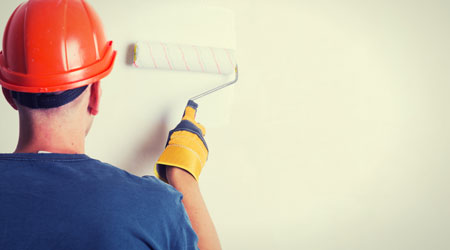Preparing to Repaint: Steps to Take for a Successful Project
Whether it’s a new paint job or recoating of an existing paint, the success of that project is made or broken in the preparation phase.
Before repainting, maintenance technicians might need to perform an adhesion test to ensure that the new paint and the existing paint are compatible. This test also will reveal how well the existing paint is anchored to the substrate.
“We often find painters will decide to go over the top of an existing coating, and they don’t take the proper steps to identify the adhesion of the existing coating to the substrate, what coating they should use or what primer is necessary to get a good bond to the surface,” Neff says. “When this happens, the paint may look great for a while, but sooner or later, issues such as cracking and peeling will begin.”
For interior and exterior surfaces, Neff recommends following ASTM D3359, a standard test method for measuring adhesion of a coating system by tape.
“Using a razor blade or crosshatch tool, the user cuts into the surface of the coating, places tape over the top of the area, and then rips it off like a Band-Aid,” she says. “Look to see if the paint is intact, if it was removed, or if it’s peeling in the areas of the cut. The best adhesion strength is a rating of 5, which is what we recommend.”
But even the best-matched coating system with excellent adhesion strength falls short if the paint is poorly applied. One of the concerns paint manufacturers have is that technicians don’t use enough paint to cover the surface sufficiently.
“Sometimes the painter skimps on applying the paint the way it’s designed to be painted,” Watson says. “They fail to put it on at the square footage per gallon that we typically recommend.”
To avoid this potential issue, he recommends that technicians use a wet film thickness gauge placed against the wet paint film to measure how many mils of paint are being applied to the surface.
Conversely, applying too much paint can have a negative impact on the substrate’s vapor permeance.
“If I put on 40 mils instead of the recommended 10 mils, then I’ve significantly affected the ability of that material to breathe, depending on the chemistry of the material,” says Boyer. “So make sure you follow the manufacturer’s recommendations to a ‘T.’”
Unfortunately, even the most skilled painter cannot overcome the adverse effects of using the wrong tools. Manufacturers find that managers are willing to pay for quality paint but often make the mistake of buying cheap rollers and brushes.
“If I buy a $70 gallon of paint and apply it with a dollar roller, it’s going to give me a cheap finish,” Watson says. “So skimping on product and quality can have a negative effect on your paint application.”
An ounce of prevention
Buildings fall into disrepair, and natural elements can wreak havoc on painted surfaces. For these reasons, coating manufacturers recommend a regular maintenance review to identify potential problems and fix existing ones.
“Make sure your HVAC systems are functioning properly to maintain the balance of airflow inside and outside the building,” Boyer says. “If you have an overhang that drips into dirt that may splash back on the wall, consider installing plants or shrubs or spreading straw around the base of the wall. So make sure you do a visual inspection and identify areas for routine or preventive maintenance annually or every other year, depending on the product you’re using.”
Painted surfaces also should be kept clean because dirt and grit can take a toll on the coating, reducing its service life. Toward this end, maintenance technicians should address stains or spills as quickly as possible and make sure they use cleaning products approved by the coating manufacturer.
Kassandra Kania is a freelance writer based in Charlotte, North Carolina.
Related Topics:













